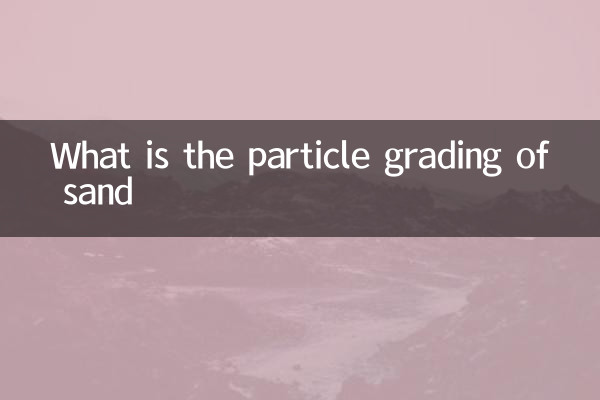What is the particle grading of sand
The particle grading of sand refers to the distribution ratio of particles of different particle sizes in sand, and is one of the important indicators for evaluating sand quality. Good particle grading can improve the density and strength of sand, thereby playing an important role in construction engineering, concrete preparation and other fields. This article will introduce the definition, importance, detection methods and related data of sand particle grading in detail based on the popular topics and hot contents of the entire network for the past 10 days.
1. Definition of particle grading of sand

The particle grading of sand refers to the distribution of particles of different particle sizes in sand. Usually, it is determined through screening tests. The sand sample is passed through a series of standard screens, and the residual amount on each screen is weighed separately to calculate the percentage of particles of each particle size. Sand with good particle grading has uniform particle size distribution, can effectively fill voids and improve the compactness and strength of the material.
2. The importance of particle grading of sand
1.Improve density: Good particle grading can reduce voids in the sand and improve density, thereby enhancing the mechanical properties of the material.
2.Improve workability: In concrete preparation, reasonable particle grading can improve the concrete and ease and facilitate construction.
3.Save costs: By optimizing particle grading, the amount of cement and other cementitious materials can be reduced and engineering costs can be reduced.
3. Detection method of sand particle grading
The particle grading of sand is usually detected by screening tests. The following are common screening test steps:
| step | Operation content |
|---|---|
| 1 | Take a representative sand sample and dry until constant weight. |
| 2 | Place the sand sample into a standard screen (such as 4.75mm, 2.36mm, 1.18mm, etc.) and sieved in sequence. |
| 3 | Weigh the residual amount on each screen and calculate the percentage of particles of each particle size. |
| 4 | Draw the particle grading curve and analyze the grading situation. |
4. Standards for sand particle grading
Sand for different uses has different requirements for particle grading. The following are the commonly used sand particle grading standards in construction projects:
| Mesh hole size (mm) | Cumulative sieve percentage (%) |
|---|---|
| 4.75 | 0-10 |
| 2.36 | 10-35 |
| 1.18 | 35-65 |
| 0.6 | 65-85 |
| 0.3 | 85-95 |
| 0.15 | 95-100 |
5. The relationship between popular topics on the entire network in the past 10 days and the particle grading of sand
1.Environmentally friendly building materials: Environmentally friendly building materials have become a hot topic recently. Optimizing the particle grading of sand can reduce resource waste and conform to environmental protection trends.
2.Concrete technology innovation: Innovation in concrete preparation technology is closely related to the particle grading of sand, and good grading can improve concrete performance.
3.Construction project quality: In the discussion on the quality of construction projects, the particle grading of sand is considered to be one of the key factors affecting project quality.
6. Summary
The particle grading of sand is an important indicator for evaluating sand quality, which directly affects the density, strength and working nature of the material. Through screening tests, the particle grading of sand can be detected and the appropriate grading of sand can be selected according to different uses. In light of recent hot topics, optimizing the particle grading of sand can not only improve the quality of the project, but also respond to the needs of environmental protection and technological innovation.

check the details

check the details